The first striking thing about Aetheris is its strange and colourful look. The second thing that strikes about Aetheris is the gorgeous animations and storybook trappings of its presentation, even in its loading screen transitions. The third is the strange vulnerability radiating from the village of lizardy people you’re responsible for, and the parties you form with them. The fourth striking thing is that this a roguelike, it’s a bloody roguelike isn’t it, oh goddamn it.
It also binds the spacebar to “accept”, something I learned by accidentally starting a bossfight in a terrible position that threw a whole party away. Or would have, if not for the ol’ ctrleffor. I will never be stopped.
The fact that I kept playing instead of sulking and libelling a random CEO is a hint: I bloody love Aetheris.
I’ve slammed a game for being “the corruption is spreading” again, but that’s not innately bad. Here you’re told little beyond “the Shade is coming! Pick four villagers and send them towards the distant pillar of light”, and then you’re off on a series of sometimes random events and turn-based battles, with all the hexes and the action points and that. But Aetheris immediately makes that engaging with its captivating presentation, and limited context. There’s no dreary In The Ancient Times backstory, and no (ugh) “lore”. There’s no map, or any indication of how far away your goal is: each area, and its residents, are a fresh mystery.
You might find mention of outside groups like the “Noseys” or “Hostiles”, but little elaboration. The almost childlike directness of the names might suggest something about your people (vazzards), but it’s open to interpretation. At no point have I even been told what a “normal” vazzard is, what they value, or what’s expected of them. Are they ignorant isolationists? Naive innocents? Calculating and vicious little bastards? If your party is particularly pragmatic, is that typical for warriors? Do they even have warriors or are these level 0 rubes just whoever’s un-lottery ticket came up?
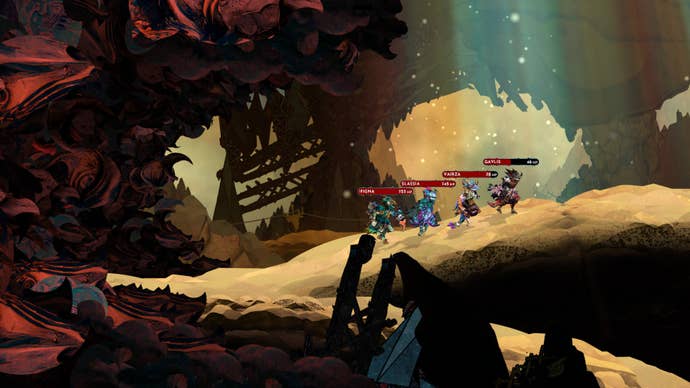
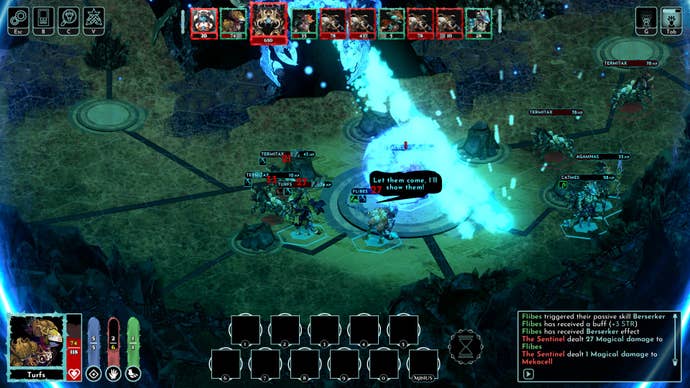
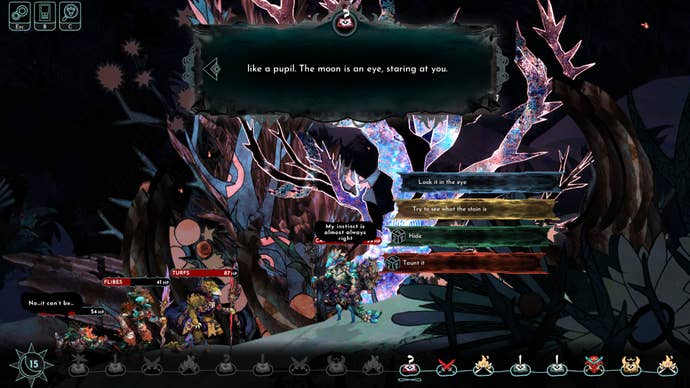
These are not central questions. Aetheris is not an introspective or philosophical game. But they play into its greatest strength: an atmosphere and sense of a unique world that doesn’t explain itself to or your vazzards. They’re slightly odd, dramatic little guys, taunting and fretting through speech bubbles in combat, bickering during events. Even when racking up a body count, they feel vulnerable, desperate, and sad. Instead of photocopying the FTL travel map again,you’re given upfront the exact order of upcoming events and fights. This gives you room to plan, especially for the campfires, at which the party rest, pray, or train as one. The first two restore everyone’s resources, encouraging risktaking or blasting if one member is in bad shape. The latter rewards XP if you need neither. The fourth option is to keep moving. You’ll get used to the odd feeling of your party being off-centre when the Shade starts to catch up, because, you see, they don’t just blink to the next event. They walk.
Your little guys walk past looming statues and ruins, alien forests and vistas, colourful abstract skies, across multiple parallax layers. Even the ground sometimes moves up into place beneath your vazzards like a theatre profile during scene transition. You don’t know what any of this is, and neither do they. But it’s beautiful. You can hurry them along, but seldom will. It feels wrong. It’s the long travelling montage parts that seldom feel like a journey in games, with the theatrical air of a diorama cut and painted by hand over hundreds of hours, just to bring a little extra magic into your life.
Where Wildermyth’s characters were a cartoony paper cut-out, Aetheris’s creatures are several overlapping ones, limbs swinging, heads bobbing, monsters whirling arms up in dismay when surprised by a snare. Each piece is absurdly detailed – stop to look sometime at their armour, the headdress, the rich variety of their skin. This is a game that is really going for it visually. The music is similarly excellent, building up military march beats from tense strings and slightly mournful horns, and just a hint of those mischievous twinkly motifs that you think of when there’s old-fashioned fairy nonsense afoot, gently steering it away from the sombre vibes of The Banner Saga. I haven’t even got into the dramatic screen-warping effects when you’re hit by a spell, or the way everyone leaps high in the air for every critical hit.
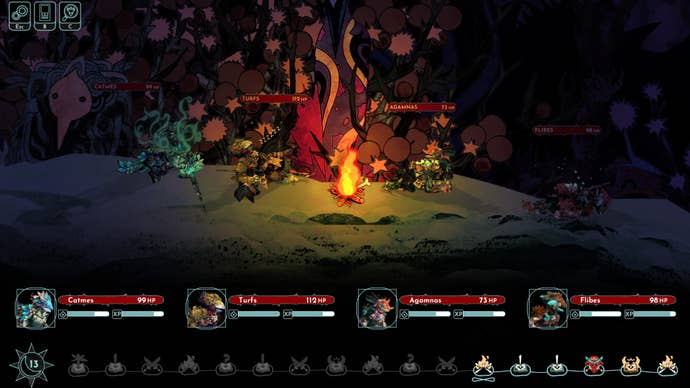
I’ve spent a lot of words on aesthetics, because that character and sense of exploring the unknown primes you to approach its strategic challenges like that. Its lack of defined norms extends to developing a party: it’s strictly one weapon and two items per character (there are no consumables at all, a huge improvement), but those can be anything you have, because there are no prerequisites or classes. Each level asks you to choose from four attitudes: empathy, brutality, rationality, or mysticism. Two related (somewhat randomised) stat improvements are then offered, of which you pick one. And then the cards come out. Oh no.
Fellow card resenters, fear not. The cards are fully contained to this screen. The last part of levelling shows two piles, face down, representing passive and active skills. You take two cards in whichever combination you like, then turn them over, and pick one. The other is lost for that character forever. You are shown the WoW-style rarity of the next two cards in each pile, however, introducing questions of whether to ignore passives to gun for a rarer active skill now, save it for a later level, or ignore it since you want passives more.
There’s really no gaming it. There’s no guarantee you’ll ever be offered something specific. This has obvious downsides, sometimes lumping you with unhelpful or redundant abilities, and an early rare skill could require more action points than a vazzard’s entire capacity. Do you write that skill, or gamble that you’ll find a way to bring it online?
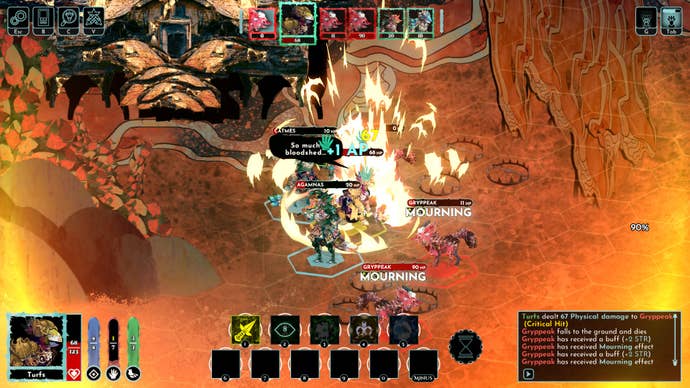
But a party can do well despite those inefficiencies, and it can lead to some powerful or amusing combinations. Even common skills can be disproportionately useful (conversely, some are too costly to bother) with the right pairing, and since the options are drawn from a deck rather than a tree or linear upgrade path, and the available possibilities within each attitude diminish each time you select it, you’re naturally encouraged to choose a mix of attitudes rather than minmax one for each party member. Individual vazzards don’t reach the poignancy or personal resonance of Wildermyth’s characters, but they tend to become their own weird little thing you have to figure out how to work with.
The oddness and variety of enemy skills and behaviours also encourage reciprocating with a “be ready for anything” approach to levelling and fighting. My “bad luck” with repeated Empathy picks, ostensibly the healing-focussed choice, produced a vazzard with no active healing powers but a heap of passives that, with the right equipment (all of which is quite particular; a sack of tools rather than a number transmitter), let them wade in while their health regenerated and poison drained the enemy’s. It was funny enough walking directly up to a boss, ignoring the summoned lackeys, before picking Rational later added the power to set traps behind them, punishing retreat as well.
Many enemies, and especially boss fights, are unorthodox but not overly gimmicky – though a few feel rather overtuned. I’ve some fantastic screenshots I won’t share, because you too deserve to experience the genuine “Oh my god what is that? We are so hosed” moments. Some of which I survived, once with a dramatic last ditch gambit that cost a vazzard’s life. The remaining three survived a surprisingly long time afterwards. They’d have made it through another boss fight too, if only they weren’t one down. Or I’d come up with a better plan than “keep its attention on Catmes” (RIP).
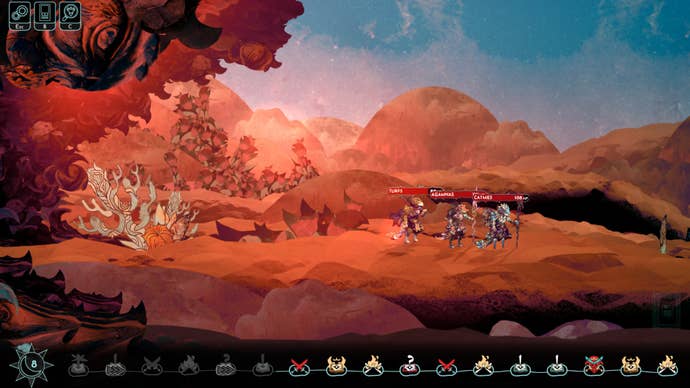
Death isn’t absolutely final, since vazzard ghosts can be attached to a new character, boosting stats and taking one deathblow. The cost is blocking some achievements, which unlock new skill cards for everyone, another source of meta-progression. My Marotic weariness of roguelikes means I’ve no conclusive opinion on whether that’s a good thing, even if my reflexive thought is “Oh good, I love wasting my time for no reason”. It’s disappointing, though, that nobody comments on casualties, and there’s no ceremony or summary when a party is lost.
Perhaps most boldly, risky choices during events don’t, I am fairly confident, lean on stats. They’re a raw 50/50 every time. You can always choose a safer course, and that’s often wise, because while a lucky toss could skip a fight or lend a whole team of AI-controlled allies, really bad ones could permanently weaken your whole party. But the love and dedication put into its art and strange personality tells me that all this uncertainty, the unpredictable and sometimes disastrous unknowns, aren’t just the usual unexamined roguelike trappings. It could easily have done that and made a generic roguelike with a pretty face, but the tone it sets is meant to encourage interpretation, and carry that over to how you play. Its otherworldiness and style invited me to inhabit Aetheris, to discern its unusual design, despite some familiar elements. To really sit with each party and try to strategise a way for their particular mess to work, instead of trial and erroring my way to an ideal.







